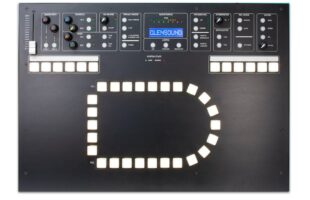The 2008 Beijing Games, at US$43 billion, are already the most expensive of all time. Over half a million visitors watched more than 11,000 athletes compete. Television cameras and content delivery networks linked the 31 Beijing-based venues and the six venues outside Beijing, as well as 59 training centers, to deliver up-to-the-minute footage throughout. The Host Broadcaster provided international television and radio signals and all other necessary broadcast facilities to rights-holding broadcasters and employed more than 5,000 staff during the Games, covering 302 events taking place in 37 different competitions and several non-competition venues. The heartbeat of the broadcasting operation, running 24 hours a day, was the 55,000 square-meter International Broadcast Centre (IBC) in the newly-built National Convention Centre within the Beijing Olympic Green. The International Olympics Committee says there were over 250 rights-holding broadcasters, with over 12,000 on-site staff. In May this year, China Central TV went to air with two new digital channels, including one HDTV channel dedicated to world-class sports broadcasting and the state broadcaster supplied feed to the Beijing Olympic Broadcasting Company (BOB) from August 8 – 24 2008. Supporting CCTV’s move into HDTV was a new UHF combining system from Radio Frequency Systems (RFS). According to Norm Franke, RFS Broadcast Sales Manager Asia, RFS supplied a three-channel directional waveguide combiner in support of the new digital services, for installation at CCTV’s landmark television tower – the tallest structure in Beijing. The RFS combiner allows CCTV to combine an existing analogue channel (Ch 27) with the new HDTV sports channel (Ch 32) and standard-definition digital channel (Ch 33). “The combined signals are broadcast through a single existing broadband antenna, thereby achieving optimum utilisation of the site’s available infrastructure,” Franke said. Providing a range of MPEG-4 AVC and MPEG-2 compression equipment and professional receivers to a number of major broadcast organizations across the globe including the Host Broadcaster, EBU and Televisa, were Tandberg Television. ”With an estimated four billion potential viewers and 5,000 hours of coverage, the Beijing Games represent the pinnacle of broadcast television, live television and sports broadcasting rolled into one,” comments Dario Choi, VP and general manager of Tandberg Television Asia Pacific. Tandberg TV is supplying the Host Broadcaster of the 2008 Beijing Games with a range of MPEG-4 AVC video compression equipment and professional receivers for broadcasting of the Games. The solutions include EN8090 MPEG-4 AVC HD encoders and the RX1290 multi-format Professional Receivers. The system will be managed by nCompass Control. Live high-definition feeds will be encoded in full 1080i resolution at two bit-rates simultaneously to fit different IP transmission paths. At the same time, each HD source will be internally down-converted inside the encoder, offering up to full resolution standard-definition MPEG-4 AVC. Providing a comprehensive array of services to rightsholders and non-rightsholders for worldwide distribution, were GlobeCast. For rightsholding broadcasters, dedicated HD and SD uplink paths are available from the IBC (International Broadcast Centre) satellite dish farm, for end-to-end delivery of the ABU (Asia-Pacific Broadcasting Union) sport pool’s World Feed. GlobeCast also provided multiple unilateral feeds (including 2 in HD) for clients including ATV (Hong Kong), I-Cable (Hong Kong), Solar Entertainment (Philippines), TV Globo (Brazil). GlobeCast managed the largest share of outward transmissions from the International Broadcasting Centre, and provided services using advanced transmission standards including HD in MPEG-4 and DVB S2 modulation. Outside the IBC, GlobeCast worked with 7BMC to offer services to non-rightsholding broadcasters, including playout and international delivery via satellite and fibre in partnership with local authorised Chinese service providers. Clients include CNN, ESPN, France 24, Orange, TVAsahi, TV Tokyo, Nippon TV, Rede Record (Brazil), KBS (Korea), Reuters, TV3 (Malaysia) and ETV (South Africa). GlobeCast also secured live stand-up positions at Pangu Plaza and Crouching Dragon Market, with one of the best views of the national stadium (Bird’s Nest) and the aquatic centre (Water Cube) in the background. GlobeCast will also be covering the Paralympics in September. And satellite operator Asia Broadcast Satellite (ABS) was selected by Eurovision as its satellite broadcast partner for the Games. ABS provided two C-band transponders on its ABS-1 satellite for Eurovision’s live transmissions from Beijing throughout the month of August. “ABS-1 is an essential part of our transmission network for the Olympic Games by transporting live High Definition events from the Olympics in Beijing, China, for distribution in Europe. We uplinked to ABS-1 from Beijing and downlinked directly in Europe in a single hop, lowering our costs and improving reliability for this premier event,” said Paulo Pusterla, Eurovision’s head of strategy and business development. “ABS is extremely excited to be selected by Eurovision as part of their critical delivery solution for one of the world’s most prestigious sporting events,” said Tom Choi, CEO of ABS. “At 75°East, ABS-1 is strategically located for interconnecting Asia and Europe, making it the ideal choice for direct transmission of live sports, news, and entertainment where service reliability and low latency are critical.”
Ad – Before Content
Related Articles
Keshet International sells Tuesday’s Child TV’s The Hit List to M6 Groupe in France
Glensound Debuts European Parliamentary Broadcast System at ISE 2025
- PROVYS Technologies Reports an Active and Successful 2024
Screenshot
ZEE5 Global announces the World Digital Premiere of The Sabarmati Report
CBC announces Ioanna Roumeliotis as new host o THE FIFTH ESTATE
- Season Two of HBO Original drama series The Last of Us debuts in April
Courtesy of HBO








